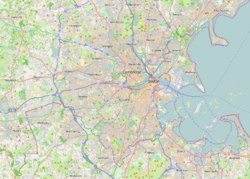Newton Highlands is one of the thirteen villages within the city of Newton in Middlesex County, Massachusetts, United States.[1] The Newton Highlands Historic District includes residential and commercial businesses back to the late 19th century.
Newton Highlands, Massachusetts | |
|---|---|
Village | |
 Lincoln Street | |
| Coordinates: 42°19′15″N 71°11′58″W / 42.32083°N 71.19944°W | |
| Country | United States |
| State | Massachusetts |
| County | Middlesex |
| City | Newton |
| Time zone | UTC-5 (Eastern (EST)) |
| • Summer (DST) | UTC-4 (EDT) |
History
editJohn Haynes owned much of the land that is now Newton Highlands in 1635. He was the governor of the Massachusetts Bay Colony. The area was primarily farm land until train service was brought to the area.[2] The Charles River Railroad extended its service in the Newton, Massachusetts area, from Brookline to Newton Highlands. It was called the Highlands Branch.[3] Initially, train service was just for commercial traffic. In the 1870s, commuter service was extended from Boston to the village.[2]
The historic commuter suburb was platted after 1852 when the Charles River Railroad was first built. The streets included Floral, Lincoln, Walnut, and Hyde Streets. Land north of Lincoln Street was subdivided for more streets in 1871.[4] As the village was settled in 1870s, houses were built of Mansard, Colonial Revival, Italianate, and other forms of Victorian architecture.[2] Late 19-century historic houses, some businesses, the Newton Congregational Church, and the Hyde School are located in the Newton Highlands Historic District.[5] Boston architects designed brick buildings to replace old wooden schoolhouses in the 1890s. Hartwell and Richardson designed the Hyde School, which was dedicated in 1895.[6] The first Brigham's Ice Cream shop was located in Newton Highlands.[7]
Attractions
editTrain service
editNewton Highlands has two stations on the Green Line D branch: the Newton Highlands and Eliot stations.[2]
Historic landmarks
edit- City Stable and Garage (74 Elliot St); an early garage built in 1926 in the style of a traditional city stable.[8] A sign now stands outside the garage saying "MUNICIPAL VEHICLES ONLY; NO PRIVATE VEHICLES ALLOWED".[9]
- Fred R. Hayward House, 1547 Centre St
- House at 230 Winchester Street
- Needham Street Bridge, a bridge carrying Needham St over the Charles River into Needham, built in 1875.[10]
Notable person
edit- Benjamin Franklin Trueblood (1847–1916) was an American pacifist who served the American Peace Society for 23 years[11][12]
See also
editReferences
edit- ^ "City of Newton, MA". www.newtonma.gov. Retrieved February 17, 2022.
- ^ a b c d Gordon, Heather (2004). Newcomer's Handbook For Moving To And Living In Boston: Including Cambridge, Brookline, And Somerville. First Books. pp. 103, 108. ISBN 978-0-912301-54-9.
- ^ Fleishman 2004, pp. 27, 35, 36, 38, 40, 48.
- ^ "Newton, Massachusetts Community Preservation Program Funding Request". Newton, Massachusetts.
- ^ "Newton Highlands Historic District". Trust for Architectural Easements. Retrieved February 16, 2022.
- ^ Fleishman 2004, pp. 125.
- ^ Brigham's History
- ^ Jenkins, Candace; Abele, Susan (March 1988). "FORM B - BUILDING" (PDF). mhc-macris.net.
- ^ "74 Elliot St · 74 Elliot St, Newton, MA 02464". Google Maps. Retrieved January 25, 2024.
- ^ Stott, Peter (April 1986). "FORM F - STRUCTURE" (PDF). mhc-macris.net. Retrieved January 25, 2024.
- ^ "American Peace Society Photograph Collection, Swarthmore College Peace Collection". www.swarthmore.edu. Retrieved February 16, 2022.
- ^ "Dr. Trueblood, Publicist, Dead: Had Been Noted for Work for Peace". Boston Post. October 27, 1916. p. 1. Retrieved February 16, 2022.
Bibliography
edit- Fleishman, Thelma (2004). Newton. Arcadia Publishing. ISBN 978-0-7385-3774-0.


